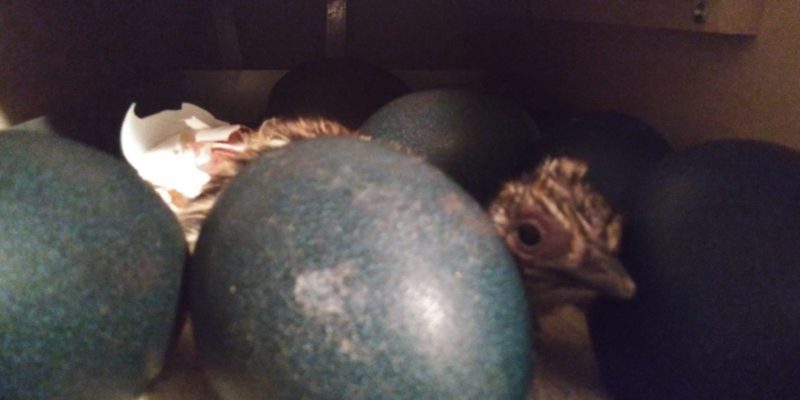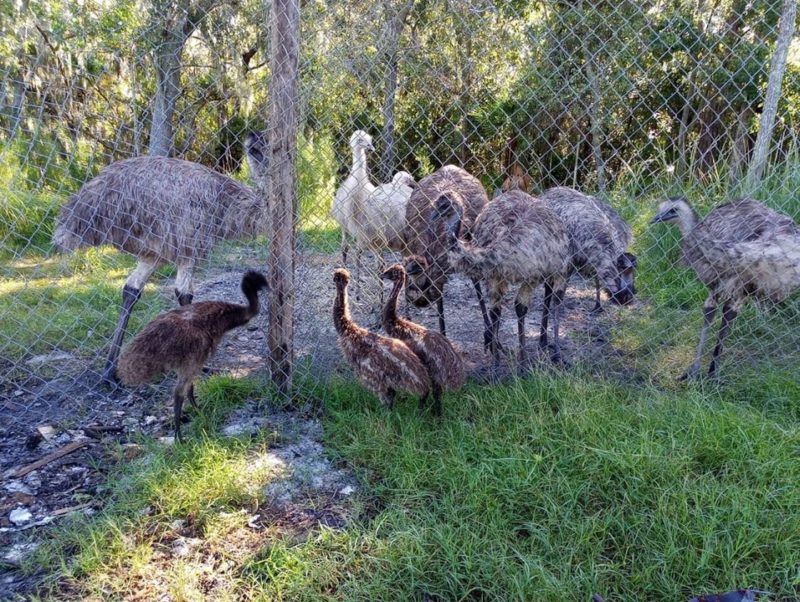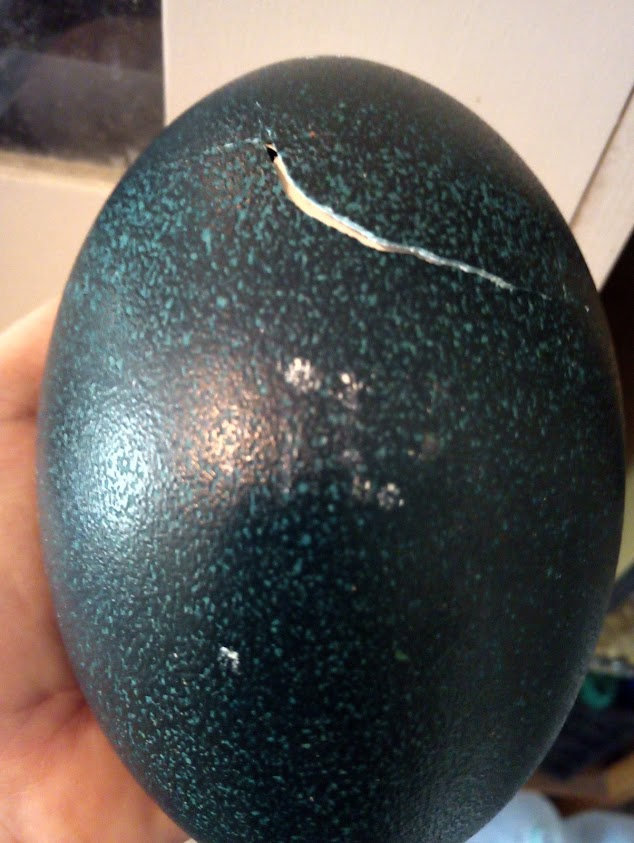If these large birds intrigue you, hear from a long-time emu breeder Alexandra Douglas about how to navigate raising them. All photos by author.
There has been a growing popularity with emus over the last few years. Although the main uses for emus are for meat, eggs, and egg art, many are considering emus as pets. As a breeder, I see them more as livestock, but I can understand why many see them as pets. They’re a very inquisitive breed of bird and, if raised from the beginning, quite friendly.
My Emu Experience
My fascination with emus started in my college days. I’ve always been a dinosaur fan, and I dreamt of having this giant bird in my backyard; it would be my own Jurassic Park. Like any beginner, I thought I could hatch some like I would chickens and go from there. I didn’t realize how hard it is to hatch an emu, especially in a high-humidity state like Florida, where I live. I failed many times, and then I finally hatched one chick back in 2010.

Small emu fighting its way out of its egg.
After hatching the chick, I didn’t realize that they have many needs, unlike the other fowl I was more familiar with. Emus need customized nutrition, housing that doesn’t make them slip, and patience. My little chick unfortunately splayed his legs, and I had to get him euthanized. But I did not give up. With more research and a better setup, I was able to obtain my first pair of emu chicks, and those two were what grew my mob. Ten years later, I have an established mob with all three colors of emus. Yes, emus come in more than one color – common, also known as the wild-type pattern, blond, and white.
Emu Fast Facts
Here are some more interesting facts about emus:
- The emu is the second largest bird, the first being the ostrich.
- Emus are large flightless birds in the ratite family.
- Emus have a vestigial tongue and wings. Instead of a wing, they have wing stub and nail in its place.
- A group of emus is called a “mob.”
- The male emu incubates the eggs and raises the chicks.
- Emus swim very well and can run up to 31 miles per hour. They can travel far distances at ease.
- Emu season is November to April in the United States. Females usually start laying as soon as 18 months, but some will lay once they reach 3 years or older. Every bird is different. Males tend to reach maturity at 2 years of age, closer to 3. A single hen will lay anywhere between 20 and 50 eggs a season.
- In history, there was the Great Emu War in 1932 between wildlife military operations and emus, due to emu nuisance and wild emus running all over. The emus won.
Emu Housing
Emus can get to 6-1/2 feet tall; therefore, a tall fence is needed. Some breeders use a 4-foot fence; however, I recommend at least 5 feet. Our pens are 8 feet high. When startled, emus won’t jump over a fence but will climb up. The taller the fence, the likelier they’ll stay inside, although I have had a couple climb over an 8-foot one in weak spots of fencing. I don’t recommend hot wire. Although emus are considered livestock guardians to ward off predators, some don’t have that instinct and may need a livestock guardian animal to protect them and their eggs, as there can be egg thieves, such as raccoons. I encountered this issue once and added a llama to help guard.

Here you can see babies and adults separated by an 8-foot fence.
A pair of emus can be housed in 1000 square feet of space, but I like to give them more. A shelter is helpful for the birds to go under. Here in Florida, mine don’t really use their shelter; however, in colder climates, that may be a different case.
Emus love water. I always think of them as giant ducks. They’re good swimmers when given the opportunity. Adding larger kiddy pools or large water bowls into their habitat will allow the birds to drink and play.
Emus can be housed with other livestock and poultry if raised with them from the beginning. Our first emus were housed with goats, a donkey, and geese. As we grew the mob, they’re now in their own pens. Some goats and livestock will chew the feathers off of emus out of boredom; therefore, always keep an eye on your animals if you’re commingling species.
Nutrition
There are a few emu commercial feeds out there, but from my experience, many breeders and emu owners mix their own formulas. For emu chicks, I give them an emu starter for their first year, and then I transition them to “breeder formula” food. While there is also a “maintenance formula”, we prefer to go straight to the breeder formula because emus can start laying eggs very soon after reaching maturity. We opt to give them the greater level of protein in the breeder formula.
Emus are naturally deficient in vitamin B12 and vitamin E/Selenium. Give kale and spinach as treats to chicks, juveniles, and adults. There’s also a rooster booster powder of vitamins sold at feedstores that can be sprinkled over the food.
Vaccinations
Depending on location, vaccinations are needed for emus. Here in Florida, Emus need the Eastern equine encephalitis (EEE) vaccine. EEE is a deadly virus for emus and equine. I recommend finding a veterinarian or experienced breeder to assist you on the proper vaccination and if it’s needed in your area.
Ways to Obtain Emus
Here are some options for how you can get emus:
Hatching Eggs
Some breeders will sell their hatching eggs from emus, so you can try hatching them out. Unlike chickens and other fowl, emu eggs need to be incubated at 97.5 degrees Fahrenheit and at a low humidity level of at least 30 percent. The higher the humidity, the more likely the embryo may drown in the shell. I hand-turn my eggs 3 to 4 times a day and let them air out to give them more ventilation.

An emu egg pipping!
Emu eggs take 49 to 55 days to hatch. Some can take up to 60 days, but the average is more so 52 days. Emu eggs can’t be candled, but they can be weighed weekly to see if they’re losing the proper weight throughout. This shows you if the eggs are developing or are duds. There are other methods of testing to see if the egg is developing. You can perform the tap test: Take a metal rod or spoon handle and tap the egg. If it sounds like glass, then it’s not developing. If it sounds heavy, then you have development and should continue incubating the egg. You can also leave the egg out for 15 minutes on a flat surface and see if it wiggles (around 42 days), or warm one end of the egg after leaving it out for 15 minutes.
Chicks
Many breeders will sell emus as chicks, especially those who raise more than one color in their mob. Emus are social; therefore, make sure if you get chicks that you get two or more to start with. Emu chicks are delicate for their first six months of life. Their legs in particular are fragile, and splay leg, slipped tendons, or hip issues can lead to death. It’s difficult to treat the injury when it occurs, so that’s why keeping the chicks on a non-skid surface for their first few months is important.

Three colors of emu chicks on the non-skid surface of the brooder.
Juveniles and Adult Birds
If you want a head start in raising emus, and if you’ve done your research and have proper housing and fence, purchasing juveniles or adult birds to raise would be a great opportunity. Adult birds are not recommended for beginning owners; if you’re starting out, I recommend obtaining chicks.
Before considering emus, do lots of research prior to obtaining them. There are many forums on the internet and groups on social media that can help you. Finding a mentor will also help you with success. Don’t be afraid to ask questions.
Emus are very different than other fowl. They’re large birds and have needs and shouldn’t be taken lightly. They can be dangerous due to their feet and size; even the friendliest ones should be watched, as accidents do happen.

Some of our mob.
For further reading on emus, I highly recommend The Emu Farmer’s Handbook and The Emu Farmer’s Handbook: 2 by Phillip and Maria Minnaar.
Alexandra Douglas was born in Chicago, Illinois. At age nine, she began raising psittacines (parrots). When she moved to Oregon for college in 2005, she majored in Animal Sciences at Oregon State University with an emphasis in pre-veterinarian medicine and poultry. Alexandra was hooked on quail as soon as she was handed a day-old pharaoh Coturnix. Currently, she owns Stellar Game Birds, Poultry, Waterfowl LLC, a poultry farm that sells chicks, hatching eggs, eating eggs and meat. She has been featured in Aviculture Europe and honored by the Heritage Poultry Breeder Association of America for her research on quail. Her book on Japanese Quail, Coturnix Revolution, is a comprehensive guide to raising and understanding these domesticated fowl. Visit her website or follow her on Facebook.













2 Comments
what does it cost to get into raising emus? what is the turn around time to market? what kind of penning is required to raise the birds? is there still a market for the meat? i am looking into buying some birds. how fast does the chicks grow?
thank you rusty
I have just hatched out two emu chicks. They are now a week old but one has started to put its head between its legs. It is drinking but I haven’t seen it eating and has lost weight.
Has this happened to any of your emu chicks and, if it has, can you give me advice on how to cure it.